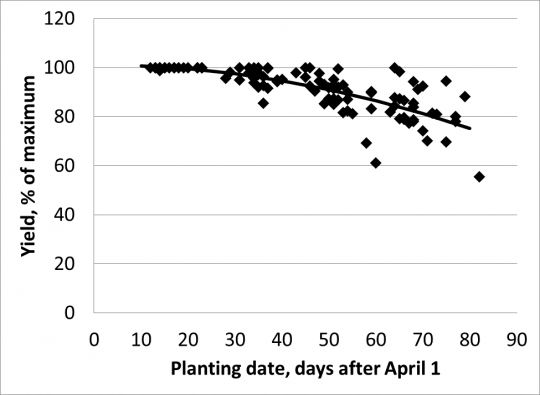ILSOYADVISOR POST
Four Soybean Seed Decisions for 2020
Even before farmers across the state have parked their combines for the winter, the time for considering 2020 seed orders is upon us. Generally, one important factor for growers when choosing seed is the performance of varieties in trials across the state. Agronomists always caution against making decisions based on one year of data. That approach would be especially risky after this season, with the abnormal weather we have encountered. A better approach is to choose varieties to plant on the majority of your acreage that have an established history of at least 2-3 years of strong performance. A few other guidelines may also be useful when choosing seed for next year.
When choosing a weed management platform, don’t forget about genetics.
There are at least five herbicide platforms available for the 2020 growing season. These include Roundup Ready 2 Xtend®, Roundup Ready 2 Yield®, LibertyLink®, GT27™, and Enlist E3™2. Others, including XtendFlex®, are not far from coming into the marketplace. While input cost is always a consideration, herbicide costs are comparable across platforms depending on where and when the chemicals are procured, as well as terms of purchase.
The presence of resistant weeds in a grower’s fields factor into this decision, as do neighboring crops, especially when planning to utilize Plant Growth Regulator (PGR) chemistries (dicamba or 2,4-D). If a platform based on PGRs is selected – and you plan to use the PGR herbicide post-emergence – talk with your agronomist or retailer about utilizing residual chemistries with the PGRs so that they can be applied as an early post-emergence application. This strategy will reduce the chances for off-target movement. Also, consider the underlying genetics of the varieties. Obviously, yield is always important, so investigate the performance history of the germplasm containing the herbicide resistance traits.
Choose seed treatments wisely.
In 2019, there was only a slight advantage to early-planted beans over later planting dates. The cool, wet conditions that prevailed for most of April and May stressed the early plantings, leading to reduced stands and lower-than-expected yields. Conversely, the growing conditions in August and September were favorable for soybean production, and even June soybean plantings yielded surprisingly well. However, this year was clearly an anomaly. University of Illinois data over several years show maximum yields attained in mid to late April, with a decrease in yield potential of about a quarter bushel a day after May 1 (Figure 1).

Figure 1 Combined results over 26 soybean planting date trials in central and northern Illinois, 2010 to 2016. (University of Illinois.)
The main factor that allows us to maximize yields with early planting of soybeans is the widespread adoption of seed treatments. Treatments allow the seeds to withstand unfavorable soil conditions, especially early in the growing season as well as combat insect pests before and after emergence. However, all seed treatments are not created equally. Not all are equally effective and specific fungicides do not protect against all fungal diseases present in the soil. Ask a trusted agronomist which seed treatments are right for the expected conditions in your specific situation.
Choose varieties with resistance to diseases present in your operation.
Seed treatments and foliar fungicides are important tools in the battle against yield-robbing diseases. However, just as important is the selection of genetics with good resistance to expected diseases. Some level of resistance is available for the most economically important diseases including Phytophthora Root Rot, Soybean Cyst Nematode (SCN), and Sudden Death Syndrome (SDS). Since these are all soil-borne, they cannot be controlled by foliar fungicides. Genetic resistance and seed treatments are the only effective ways to protect against these pathogens. Again, discuss the conditions on your farm with a trusted agronomist and they will be able to help you select varieties with the proper disease resistance profile for specific field conditions.
Spread your risk.
It may be tempting to plant all or most of your acres with a single variety that has had dominant performance in the past. However, one strategy to minimize risk is to plant a range of relative maturities to ensure that portions of your crop will be at different growth stages, enabling at least some of your acres to take advantage of favorable environmental conditions when they occur. As mentioned earlier, in 2019, the later plantings took advantage of favorable conditions very late in the year to deliver surprisingly strong performance. Planting varieties with a range of RMs increases the likelihood that some will hit that sweet spot for maximizing yield.
None of us know what the 2020 growing season will look like. However, if we can learn one thing from history, it is that it is very unlikely to be a repeat of 2019. I’m sure we can all agree that is a very good thing. Making informed seed selection decisions will go a long way in ensuring that it will be a productive year.





Comments
Add new comment